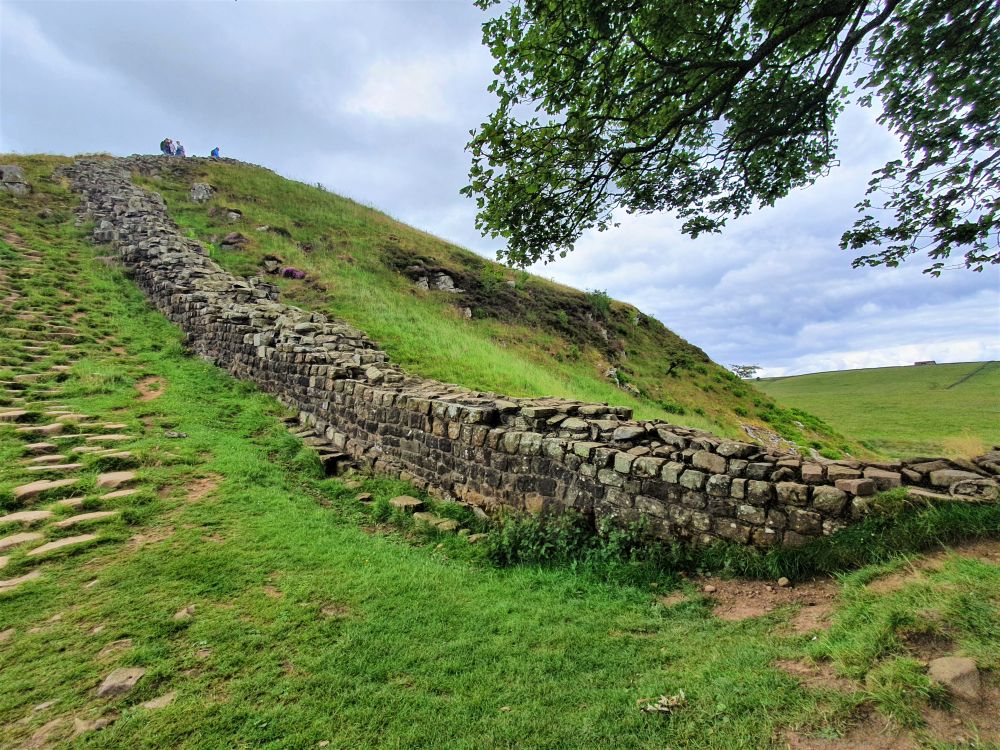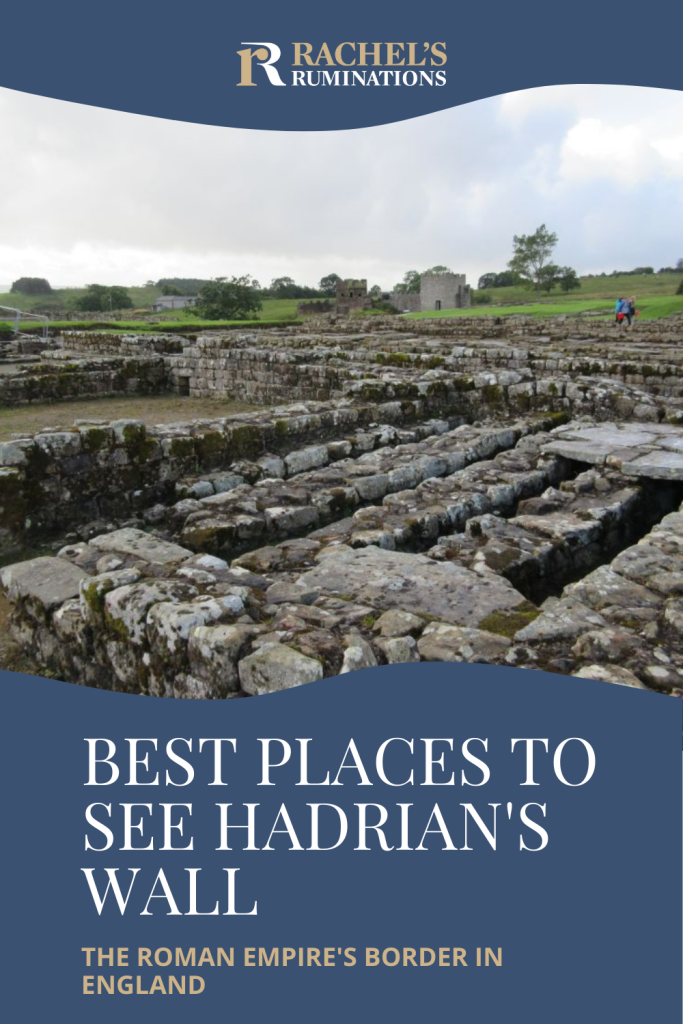Best places to see Hadrian’s Wall
A guest post by Elaine Wilson
Hadrian’s Wall is a UNESCO World Heritage Site in the North of England. Stretching 73 miles (117 kilometers) from coast to coast, Hadrian’s Wall was built to guard the wild northwest frontier of the Roman Empire. This is where the Romans drew their military line: it crossed northern Britain from Wallsend on the River Tyne in the east to Bowness-on-Solway in the west.
Updated April 21, 2025
Disclosure: This article contains affiliate links. If you click on any of them and spend money, I (Rachel) will receive a small commission. This will not affect your price.
Although it was built supposedly as a fortification, it may have also been a vanity project for the emperor Hadrian. It is certainly a unique construction in the whole of the Roman Empire.

Over time, many of the stones of the original wall were repurposed and appear in local houses, churches and bridges, but there is still plenty of the wall to see. The remains of the forts, towers, turrets and towns that once kept watch over the Wall persist and are still visible.
The story of Hadrian’s Wall
Permanent conquest of Britain began in 43 AD and by about 100 AD the northernmost army units along the wall were in place. Building of the wall began in 122 AD and it took at least six years to complete. The original plan was for a wall of stone or turf with a guarded gate at every mile point. The plan included observation towers along its length, and 14 forts were added along the route. This was an incredible feat of construction at a time when the horse was the main form of transport for everything.
Who built the wall?
The Roman army of Britain built Hadrian’s Wall. It is thought to have taken three legions of skilled infantrymen who were responsible for major construction tasks like building stone forts and bridges. Each legion was around 5,000 men.
The wall was not, however, manned by the Romans themselves. Auxiliaries manned it: strong and fit mercenaries from other countries who specialised in fighting skills.
The troops based in the forts and mile castles of the Wall were mostly recruited from the northwestern provinces of the Roman Empire, although some were from further afield: the Syrian archers, for example.

Best places to visit Hadrian’s Wall
Today you can explore the Wall’s rich history and its dramatic landscape at over 20 fascinating sites. Here are the best ones, listed in order from east to west.
Corbridge Roman Town
Not technically speaking part of Hadrian’s Wall, Corbridge Roman Town nevertheless dates from the same time period and would have served as a supply base for the soldiers defending the wall. Besides touring the remains of the town itself, the site includes a museum containing lots of artifacts recovered during excavations at the site.
Corbridge Roman Town: Corchester Lane, Corbridge, Northumberland, NE45 5NT. Open daily 10:00-17:00. Admission: Adult £11.50 if booked in advance, £14 if bought on arrival; child £7/£8.50. Website.

Chesters Roman Fort and Museum
Chesters was a cavalry fort. You can visit the remains of the fort, Roman baths, steamrooms and officers’ quarters. The fort held 500 cavalrymen, who lived in close proximity to their horses so they could be ready to ride at a moment’s notice. The site also has a small museum.
Chesters Roman Fort and Museum: Chollerford, Hexham, Northumberland, NE46 4EU; 1⁄4 mile west of Chollerford, on B6318. Open daily 10:00-17:00. Admission: Adult £11.50 if booked in advance, £14 if bought on arrival; child £7/£8.50. Website.
Housesteads Roman Fort
Sited at about the mid-point of the wall, Housesteads Roman Fort is the most complete remaining fort that has been excavated. Its garrison of soldiers numbered about 800. Today, you can visit the ruins and see the wide view of Hadrian’s Wall. That view makes it clear why this site was chosen for the fort.
Housesteads Roman Fort has a museum as well. There, you can learn about the history of the fort as well as gaining insight about life for Roman soldiers stationed there. The museum also houses a collection of items uncovered in excavations at the site.
Housesteads Roman Fort: Haydon Bridge, Hexham, Northumberland, NE47 6NN. Open daily 10:00-17:00. Admission: Adult £11.50 if booked in advance, £14 if bought on arrival; child £7/£8.50. Website.
Buy your ticket.

Vindolanda Roman Fort and Museum
The best fort and museum along the Wall, in my opinion, is Vindolanda. It is a 2000-year-old Roman frontier fort on Hadrian’s Wall. This private museum belongs to the Birley family, who are dedicated to the discovery and preservation of this Roman site. Vindolanda conducts live excavations for budding archaeologists on the site of the fort every summer. Places on these two-week digs are very much in demand from enthusiasts all over the world.
Vindolanda is a real family affair: Eric Birley bought the land and began excavating it back in 1929. Later, his son, Robin Birley, who died quite recently, became director of excavations. Now, in turn, his son, Andrew, takes on this role and his wife, Barbara Birley, is the museum’s curator. Barbara is originally from Colorado and came over to join an excavation at the site, which is where she first met Andrew.
Excavations have been happening here for over 45 years. Treasures, many of which can be seen in the museum on the site, have given us remarkable insight into the daily life of the people who lived here all those years ago during the time of the mighty Roman Empire.

The Vindolanda Tablets
Vindolanda’s most famous treasures are the Vindolanda tablets which are real postcards from the past. They were written by people of the time on very thin pieces of wood and miraculously preserved in the mud beneath the fort. The tablets document business and social transactions. Some are lists of things that have been ordered from home like socks and beer. There is even a birthday party invitation.
Most of the tablets found are now in the British Museum, but you can still see some in the small museum on site.
The fort you can see today was built on top of several others. It was the constant renewal of the site which helped to create the special anaerobic conditions which have preserved artefacts so well. Other items found on the site tell us even more about who lived here. Finds include jewellery, pottery and coins as well as thousands of ancient shoes. Many of these shoes are a size thirteen or larger! The soldiers here were big strong men, professional fighters who were from countries like France, the Netherlands and Belgium. These auxiliary soldiers signed up to the Roman army for a mere 25 years. If after a quarter of a century they were still alive, they could marry and become a Roman citizen.
The view from the fort is stunning. High up there in the wilds of the beautiful Northumberland countryside there is a great panorama of open rolling fields and hills.
Roman Vindolanda Fort and Museum: Hexham NE47 7JN. Open daily 9:30-17:30. Admission: Adult £15, child £7. A combined ticket to Vindolanda Fort and Museum and the Roman Army Museum is £20 for adults, £10 for children. Website.
Sycamore Gap Tree
The Sycamore Gap Tree is one the most photographed trees in the whole country. Its location in the centre of a dramatic dip along Hadrian’s Wall makes it a natural visual spectacle. Hundreds of years old, it has been a past winner of the English Tree of the Year award.
Note added September 28, 2023: Last night the Sycamore Gap Tree was cut down in an astonishing act of vandalism.
It was used notably in scenes from Kevin Costner’s 1991 film Robin Hood Prince of Thieves. Its lack of proximity to Nottingham or Sherwood Forest was somehow overlooked by Hollywood.

The Sill visitor centre
The Sill is billed as a new Landscape Discovery Centre providing access to the whole of the Northumberland National Park. It is a welcome base from which to explore the most dramatic sections of Hadrian’s Wall.
It has exhibitions and a rooftop walk across the living roof planted with local wild flowers and grasses. There is also an an airy cafe and shop on site.
From the Sill you can easily walk to Sycamore Gap in about 40 minutes. The wall was built in a straight line and runs along every undulation of the rugged countryside. There aren’t many flat strolls along this roller coaster construction.

The Sill Landscape Discovery Centre: Bardon Mill, Hexham, Northumberland, NE47 7AN. See website for directions. Open daily 10:00-17:00. Admission: free, although the car park does charge.
The Roman Army Museum
Under the same management as Roman Vindolanda Fort and Museum, the Roman Army Museum is about 7 miles away. It focuses more narrowly on life in the Roman Army and includes many interactive elements.
Roman Army Museum: Greenhead, Brampton CA8 7JB. Open daily 9:30-17:30. Admission: Adult £10, child £6. A combined ticket to Vindolanda Fort and Museum and the Roman Army Museum is £20 for adults, £10 for children. Website.
If Roman ruins are your cup of tea, read about the Roman sites in Trier, Germany; Baalbek, Lebanon; or Ostia Antica, Italy!

Birdoswald Roman Fort
While Birdoswald Fort has pretty minimal ruins, it does have a long, unbroken stretch of the wall to view and to walk along. There’s also an exhibition about the history of the wall.
Birdoswald Roman Fort: Gilsland, Brampton, Cumbria, CA8 7DD. Open daily 10:00-17:00. Admission: Adult £11.50 if booked in advance, £14 if bought on arrival; child £7/£8.50. Website.
Some tips for visiting Hadrian’s Wall
Access to Hadrian’s Wall is free but you will have to pay to park at one of the sites along the way. The wall itself is not wheelchair accessible but the Vindolanda site has good wheelchair accessibility. Hadrian’s Wall is about an hour’s drive north of the city of Newcastle-upon-Tyne along the A69 towards Hexham.
The map below is centered around Vindolanda. By zooming out, you can find and compare accommodations near each sight mentioned in this article, all of which are marked on the map.
You can see Sycamore Gap and its surroundings in just an afternoon. Wear sensible shoes and don’t forget some water. If you want to do more exploring, you can walk the whole length of the wall along the Hadrian’s Wall Path, about 84 miles long (135 kilometers). If you are a keen cyclist you can cycle the Hadrian’s Wall cycle route too.
Some tours of Hadrian’s Wall that include transportation are available as well.
This full-day tour from Edinburgh, for example, includes Birdoswald and various other sights.
Alternatively, if you have your own transportation, take this 4.5-hour guided tour or, if you’re pressed for time, this 2-hour guided tour.
Compare rental car prices here.
Happy Birthday, Hadrian’s Wall
Hadrian’s Wall commands spectacular views across the stunning Northumberland countryside. Visitors remain fascinated by its existence and its significance in terms of both Roman and British history. In 2022, the wall celebrated its 1900th birthday.
My travel recommendations
Planning travel
- Skyscanner is where I always start my flight searches.
- Booking.com is the company I use most for finding accommodations. If you prefer, Expedia offers more or less the same.
- Discover Cars offers an easy way to compare prices from all of the major car-rental companies in one place.
- Use Viator or GetYourGuide to find walking tours, day tours, airport pickups, city cards, tickets and whatever else you need at your destination.
- Bookmundi is great when you’re looking for a longer tour of a few days to a few weeks, private or with a group, pretty much anywhere in the world. Lots of different tour companies list their tours here, so you can comparison shop.
- GetTransfer is the place to book your airport-to-hotel transfers (and vice-versa). It’s so reassuring to have this all set up and paid for ahead of time, rather than having to make decisions after a long, tiring flight!
- Buy a GoCity Pass when you’re planning to do a lot of sightseeing on a city trip. It can save you a lot on admissions to museums and other attractions in big cities like New York and Amsterdam.
- Ferryhopper is a convenient way to book ferries ahead of time. They cover ferry bookings in 33 different countries at last count.
Other travel-related items
- It’s really awkward to have to rely on WIFI when you travel overseas. I’ve tried several e-sim cards, and GigSky’s e-sim was the one that was easiest to activate and use. You buy it through their app and activate it when you need it. Use the code RACHEL10 to get a 10% discount!
- Another option I just recently tried for the first time is a portable wifi modem by WifiCandy. It supports up to 8 devices and you just carry it along in your pocket or bag! If you’re traveling with a family or group, it might end up cheaper to use than an e-sim. Use the code RACHELSRUMINATIONS for a 10% discount.
- I’m a fan of SCOTTeVEST’s jackets and vests because when I wear one, I don’t have to carry a handbag. I feel like all my stuff is safer when I travel because it’s in inside pockets close to my body.
- I use ExpressVPN on my phone and laptop when I travel. It keeps me safe from hackers when I use public or hotel wifi.




